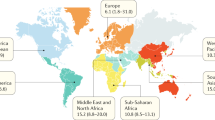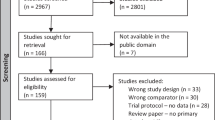Abstract
Objective:
To determine if a change in the pulse oximeter goal range and high alarm limit for oxygen saturation (SpO2) alters the distribution of SpO2 for premature infants in oxygen.
Study design:
This was a prospective, observational analysis. For group 1 (February 2002 to April 2002, n=23), pulse oximeter alarms were set at 80% (low) and 96% (high), and the goal range was 90–95%. For group 2 (May 2002 to August 2003, n=49), the high alarm was lowered to 94%, and the goal range was 88 to 94%. The SpO2 values for 24 h were downloaded from Nellcor pulse oximeters during the two periods and the percent time within, above and below the goal range was derived and compared.
Results:
Groups were similar except for use of post-natal steroids (group 2>1). The percent time within (57.7±9.8 vs 59.4±12.4%), above (15.4±10.6 vs 14±9.4%) and below (26.9±9.7 vs 26.6±10.2%) the goal range was similar for groups 1 and 2, respectively. However, the percent time with SpO2 <80% increased significantly for group 2 (4.0±2.7 vs 1.9±1.4%).
Conclusions:
Changes in pulse oximeter policy and alarms in labile, sick premature infants need evaluation for their effects on the distribution of SpO2 values before routine use.
This is a preview of subscription content, access via your institution
Access options
Subscribe to this journal
Receive 12 print issues and online access
$259.00 per year
only $21.58 per issue
Buy this article
- Purchase on Springer Link
- Instant access to full article PDF
Prices may be subject to local taxes which are calculated during checkout

Similar content being viewed by others
References
Jobe AH . The new BPD: an arrest of lung development. Pediatr Res 1999; 46: 641–643.
Jobe AH, Ikegami M . Mechanisms initiating lung injury in the preterm. Early Hum Develop 1998; 53: 81–94.
Kinsy VE . Retrolental fibroplasias. Cooperative study of retrolental fibroplasia and the use of oxygen. AMA Arch Ophthalmol 1956; 56: 481–543.
Flynn JT, Bancalari E, Snyder ES, Goldberg RN, Feuer W, Cassady J et al. A cohort study of transcutaneous oxygen tension and the incidence and severity of retinopathy of prematurity. N Engl J Med 1992; 326: 1050–1054.
Hay WW, Brockway JM, Eyzaguirre M . Neonatal pulse oximetry: accuracy and reliability. Pediatrics 1989; 83: 717–722.
Jennis MS, Peabody JL . Pulse oximetry: an alternative method for the assessment of oxygenation in newborn infants. Pediatrics 1987; 79: 524–528.
Paky F, Koeck CM . Pulse oximetry in ventilated preterm newborns: reliability of detection of hypoxaemia, and feasibility of alarm settings. Acta Paediatr 1995; 84: 6132–6616.
Wasunna A, Whitelaw AGL . Pulse oximetry in preterm infants. Arch Dis Child 1987; 62: 957–961.
Wilkinson AR, Phibbs RH, Heilbron DC, Gregory GA, Versmold HT . In vivo dissociation curves in transfused and untransfused newborns with cardiopulmonary disease. Am Rev Resp Dis 1980; 122: 629–634.
Saugstad OD . Is oxygen more toxic than currently believed? Pediatrics 2001; 108: 1203–1205.
Cole CH, Wright KW, Tarnow-Mordi W, Phelps DL . Resolving our uncertainty about oxygen therapy. Pediatrics 2003; 112: 1415–1419.
Claure N, Gerhardt T, Everett R, Musante G, Herrera C, Bancalari E . Closed-loop controlled inspired oxygen concentration for mechanically ventilated very low birth weight infants with frequent episodes of hypoxemia. Pediatrics 2001; 107: 1120–1124.
Hay WW, Rodeen DJ, Collins SM, Melara DL, Hale KA, Fashaw LM . Reliability of conventional and new pulse oximetry in neonatal patients. J Perinatol 2002; 22: 360–366.
Grieve SH, McIntosh N, Laing IA . Comparison of two different pulse oximeters in monitoring preterm infants. Crit Care Med 1997; 25: 2051–2054.
STOP-ROP Multicenter study group. Supplemental therapeutic oxygen for prethreshold retinopathy of prematurity (STOP-ROP), a randomized controlled trial. I: Primary outcomes. Pediatrics 2000; 105: 295–310.
Askie LM, Henderson-Smart DJ, Irwig L, Simpson JM . Oxygen-saturation targets and outcomes in extremely preterm infants. N Engl J Med 2003; 349: 959–967.
Tin W, Milligan DW, Pennefather P, Hey E . Pulse oximetry, severe retinopathy, and outcome at one year in babies of less than 28 weeks gestation. Arch Dis Child Fetal Neonatal Ed 2001; 84: F106–F110.
Chow LC, Wright KW, Sola S . Can changes in clinical practice decrease the incidence of severe retinopathy of prematurity in very low birth weight infants? Pediatrics 2003; 111: 339–345.
Vijayakumar E, Ward GJ, Bullock CE, Patterson ML . Pulse oximetry in infants of <1500 g birth weight on supplemental oxygen: a national survey. J Perinatol 1997; 17: 341–345.
Author information
Authors and Affiliations
Corresponding author
Rights and permissions
About this article
Cite this article
Laptook, A., Salhab, W., Allen, J. et al. Pulse oximetry in very low birth weight infants: can oxygen saturation be maintained in the desired range?. J Perinatol 26, 337–341 (2006). https://doi.org/10.1038/sj.jp.7211500
Received:
Revised:
Accepted:
Published:
Issue Date:
DOI: https://doi.org/10.1038/sj.jp.7211500
Keywords
This article is cited by
-
Target Oxygen Saturation Among Preterm Neonates on Supplemental Oxygen Therapy: A Quality Improvement Study
Indian Pediatrics (2018)
-
Hypoxic events and concomitant factors in preterm infants on non-invasive ventilation
Journal of Clinical Monitoring and Computing (2017)
-
Improving manual oxygen titration in preterm infants by training and guideline implementation
European Journal of Pediatrics (2017)
-
Advances in respiratory support for high risk newborn infants
Maternal Health, Neonatology and Perinatology (2015)
-
Compliance in oxygen saturation targeting in preterm infants: a systematic review
European Journal of Pediatrics (2015)



